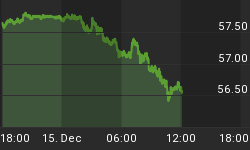Based on the December 14th, 2012 Premium Update. Visit our archives for more gold & silver analysis.
Yesterday we saw substantial declines in the whole precious metals sector (the only important exception was palladium that actually managed to close higher after a huge price drop earlier during the day) even though the Fed announced Wednesday that it would continue its monthly purchases of $85 billion in Treasury bonds and mortgage-backed securities. This makes it probable that the Fed announcement was already priced into the market, hence the lack of its reaction.
The Fed's action is clearly bullish for gold, silver and other precious metals in the long run, but recent developments along with weak correlation between metals and the dollar can keep precious metals bulls awake at night. Let us then move on to today's technical part to find out whether these fears are well-grounded. Today we'll focus on two groups of assets that usually influence precious metals the most: stocks and currencies. We'll start with the analysis of the Euro Index long-term chart (charts courtesy by http://stockcharts.com.)

A confirmation of the breakout above the flag pattern (which was a period of consolidation) has been seen in the chart. We expected this to be broken to the upside, and that's what happened. The index did pull back to the support line and has moved higher once again. The situation is now more bullish than not, but we'll wait for a move above the 132 level before stating that the outlook is indeed bullish for the weeks ahead.
Now, let's move on to the general stock market.
In the long-term S&P 500 Index chart, the situation continues to be bearish for the short term. Based on the weekly closing prices, a "gravestone doji" candlestick pattern has formed this week. This is similar to the bearish shooting star candlestick pattern. Opening and closing prices being very similar are what create the "gravestone doji". The implications of this candlestick pattern are exactly the same and are a bearish signal.
The bearish signs are actually doubled here because stocks reversed after moving to their 2008 highs and then reversing to the previously broken rising resistance line (several weeks ago). At this time, the outlook for the general stock market is bearish, but, with a support line at the $1,350 level, the downside seems to be quite limited.
Let's now have a look at the intermarket correlations to see how the above chart could translate into future precious metals prices.

The Correlation Matrix is a tool which we have developed to analyze the impact of the currency markets and the general stock market upon the precious metals sector. This week, there are not many implications here for the precious metals sector. The short-term correlations are very neutral this week so we really can't say much about the next week or two based on the currency and stock market charts.
The medium-term precious metals' picture remains bullish as there are significant negative correlations between the precious metals and the USD Index (thus the positive situation in the Euro Index is positive also for gold). Positive correlation is seen between stocks and the precious metals, so the limited downside for stocks is a bullish factor for the metals in the medium term.
Summing up, the outlook for the Euro Index is more bullish than not which directly translates into a bearish one in the U.S. dollar, especially after what we saw on the charts for the U.S. currency in our article a week ago. Stocks have a short-term bearish outlook but the downside is limited. Both: the medium- and long-term perspectives are bullish. This is not due to an improvement in US economic indicators, however, but rather due to the steps taken by the Fed, which are likely to push nominal stock prices higher.
This does not directly translate to any precious metals price moves since correlations are quite insignificant with both markets over the past 30 days. However, when we take the medium term into account, the positive correlation between precious metals and the general stock market suggests that the limited downside potential in stocks as well as their positive medium- and long-term outlooks are bullish for metals. Since the medium-term correlation between precious metals and the dollar is strong and negative, the same bullish implications for the metals follow.
Thank you for reading. Have a great and profitable week!

















